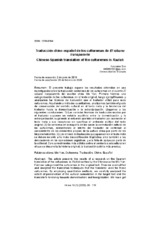| dc.contributor.author | Sun, Xiaomeng | |
| dc.date.accessioned | 2020-06-10T10:08:22Z | |
| dc.date.available | 2020-06-10T10:08:22Z | |
| dc.date.issued | 2020 | |
| dc.identifier.issn | 1579-9794 | |
| dc.identifier.uri | http://hdl.handle.net/10396/20150 | |
| dc.description.abstract | El presente trabajo expone los resultados obtenidos en una investigación sobre la traducción castellana de los culturemas en el cuento El rábano transparente del escritor chino Mo Yan. Primero hicimos una categorización de los culturemas en el texto original, luego ejemplificamos y analizamos las técnicas de traducción que el traductor utilizó para esos culturemas. Acudiendo a métodos cuantitativos, analizamos también el grado de conservación del sentido cultural en el texto meta y la tendencia del traductor hacia la domesticación y la extranjerización. Llegamos a las siguientes conclusiones: 1) Las variadas técnicas de traducción usadas por el traductor suponen un notable equilibrio entre la domesticación y la extranjerización, sugiriendo el esfuerzo que hizo el traductor por acomodar el texto meta a sus receptores sin sacrificar el ambiente exótico del texto original. 2) Se conserva en la mayoría de los casos la connotación cultural de los culturemas, demostrando el intento del traductor de contribuir al conocimiento de los elementos propios de la cultura china por parte de los hispanohablantes. 3) Los errores de traducción que aparecen en el texto meta se deben no sólo a la mala descodificación lingüística, sino también a las desviaciones en las operaciones cognitivas, y a la falta de apoyo por parte de la editorial. Con conocimientos más sólidos sobre el contexto sociocultural en el que se desarrolla la historia original, la traducción saldría más precisa. | es_ES |
| dc.description.abstract | This article presents the results of a research on the Spanish translation of the culturemes in Radish written by the Chinese writer Mo Yan. First we categorized the culturemes in the original text. Then we exemplified and analyzed the translation techniques that the translator used for those culturemes. By employing quantitative methods, we carefully analyzed the extent of preservation of the cultural connotation in the target text and the translator's tendency towards domestication and foreignization. We have got the following results: 1) The various techniques of translation used by the translator manifest a notable balance between domestication and foreignization, suggesting the effort of the translator to accommodate the target text to its receptors without sacrificing the exotic environment of the original text. 2) In most cases, the cultural connotation is preserved, demonstrating the translator's attempt to contribute to the introduction of the typical Chinese cultural elements to the Spanish speakers. 3) The errors of translation in the translated text are not only due to those false linguistic decodifications and those deviations in the cognitive operation, but also due to the lack of support of the editorial. With better knowledge of the sociocultural context in which the original story is developed, the translation would be more precise. | es_ES |
| dc.format.mimetype | application/pdf | es_ES |
| dc.language.iso | spa | es_ES |
| dc.publisher | UCOPress | es_ES |
| dc.rights | https://creativecommons.org/licenses/by/4.0/ | es_ES |
| dc.source | Hikma 19(1), 95-115 (2020) | es_ES |
| dc.subject | Yan, Mo | es_ES |
| dc.subject | Culturema | es_ES |
| dc.subject | Traducción | es_ES |
| dc.subject | Chino | es_ES |
| dc.subject | Español | es_ES |
| dc.subject | Cultureme | es_ES |
| dc.subject | Translation | es_ES |
| dc.subject | Chinese | es_ES |
| dc.subject | Spanish | es_ES |
| dc.title | Traducción chino-español de los culturemas de El rábano transparente | es_ES |
| dc.title.alternative | Chinese-Spanish translation of the culturemes in Radish | es_ES |
| dc.type | info:eu-repo/semantics/article | es_ES |
| dc.relation.publisherversion | https://www.uco.es/ucopress/ojs/index.php/hikma/index | es_ES |
| dc.rights.accessRights | info:eu-repo/semantics/openAccess | es_ES |

